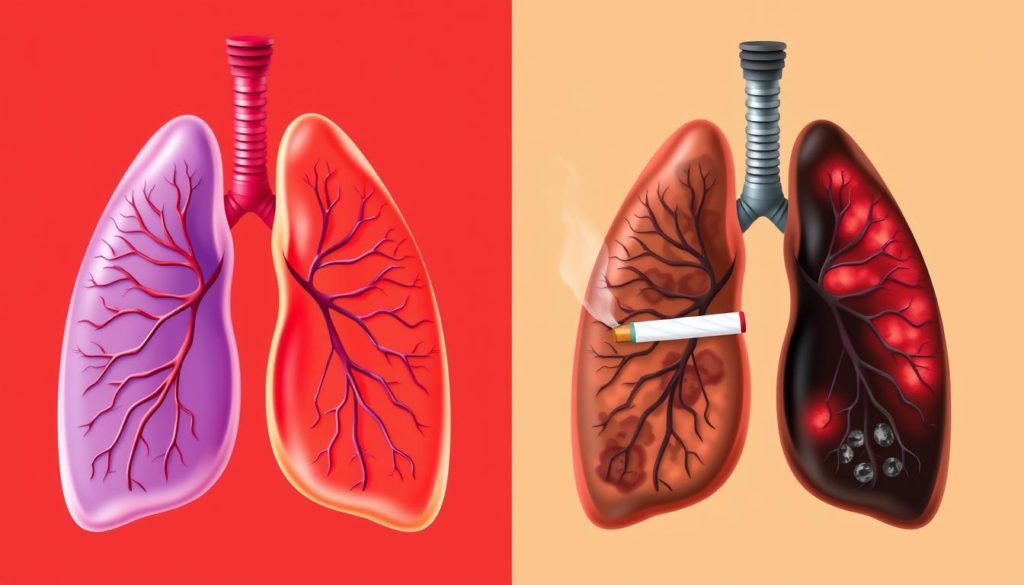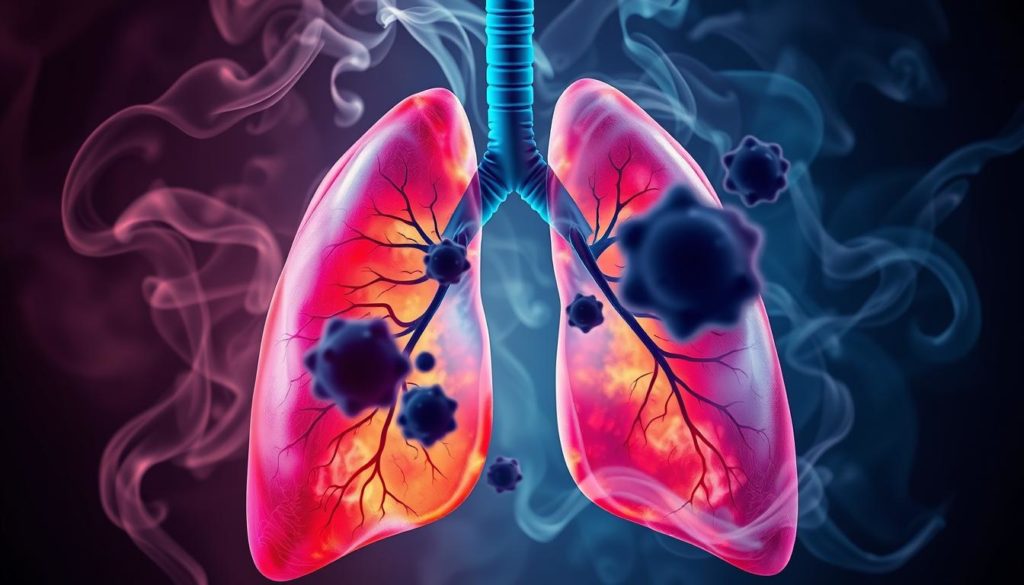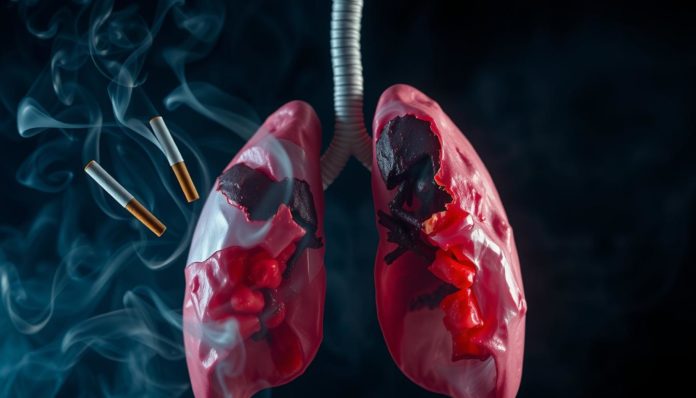Did you know over 80% of lung cancer cases are because of smoking? This fact shows the deadly link between smoking and lung cancer. It also points out why it’s key to understand how smoking affects lung health.
Smoking is proven to cause lung cancer, no doubt about it. Every cigarette puff sends harmful substances into the body. These substances damage our lungs and greatly increase cancer risk. So, is smoking behind lung cancer? Yes, research says loudly.
We’re going to look closer at why knowing about smoking and lung health matters. Awareness is very important for our health. Keep reading as we show how smoking leads directly to this dangerous illness.
The Connection Between Smoking and Lung Disease
Smoking and lung disease are closely linked, showing serious effects on breathing health. Smoking introduces harmful chemicals into the lungs. These can cause inflammation and lower lung performance. This leads to different lung problems.

How Smoking Affects the Respiratory System
Smoking harms the respiratory system both now and later. Tobacco smoke, when breathed in, irritates the airways. This can lead to chronic bronchitis among other issues. Also, these dangers cut down oxygen flow, hurting lung function.
- Airway inflammation: Constant irritation from smoke causes swelling and extra mucus.
- Reduced lung function: Lung power weakens over time, making breathing hard.
- Increased infection risk: Smoking makes lungs more likely to get infections like pneumonia.
Pathways to Lung Cancer
Cancer-causing chemicals in tobacco, such as benzene and formaldehyde, are crucial in starting lung cancer. They change lung tissue, leading to cancer. The American Cancer Society says smoking strongly links to lung cancer because of these changes.
| Carcinogen | Effect on Lung Tissue |
|---|---|
| Benzene | Causes DNA damage, leading to cell mutations |
| Formaldehyde | Induces long-term inflammation and tissue damage |
Does Smoking Cause Lung Cancer
Many wonder, does smoking cause lung cancer? Years of research clearly show smoking links to lung cancer. This has been a critical issue for health officials and smokers.

The CDC says smoking causes most lung cancers—85-90% of cases. The WHO also warns that tobacco smoke has over 70 cancer-causing chemicals.
Looking at lung cancer rates among smokers and non-smokers reveals the truth. These numbers starkly show the increased danger smokers face:
| Category | Risk of Lung Cancer |
|---|---|
| Non-Smokers | 1 in 100 |
| Current Smokers | 10-20 in 100 |
| Heavy Smokers (more than 20 cigarettes a day) | 30-40 in 100 |
The effects of tobacco on lung cancer rates are clear. But smoking doesn’t just impact the lungs. It harms other organs and can cause different cancers too. Understanding this link helps people make healthier choices and quit smoking.
Lung Cancer Risks for Smokers
Understanding lung cancer risks for smokers is crucial. Smoking and cancer are tightly linked. Tobacco is a main cause of many lung cancers. We will look at lung cancer types and how genes and the environment increase risks for smokers.
Different Types of Lung Cancer
Two main lung cancers affect smokers: small cell (SCLC) and non-small cell (NSCLC). The National Cancer Institute says SCLC is 10-15% of lung cancers and spreads fast. NSCLC makes up about 85% of cases, including adenocarcinoma, squamous cell carcinoma, and large cell carcinoma.
The National Cancer Institute reports that smoking is responsible for approximately 85% of all lung cancer cases in the United States.
Genetic and Environmental Factors
Smoking is not the only risk for lung cancer. Genes and the environment also matter. Those with lung cancer in the family may be more at risk. Things like radon, asbestos, and air pollutants also raise the risk. These factors and smoking together increase cancer chances.
- Genetic predisposition: Family history of lung cancer
- Environmental factors: Radon, asbestos, air pollution
- Interaction with smoking: Increased risk due to combined factors
| Type of Lung Cancer | Percentage of Cases |
|---|---|
| Small Cell Lung Cancer (SCLC) | 10-15% |
| Non-Small Cell Lung Cancer (NSCLC) | 85% |
Effects of Smoking on Lungs
It’s critical to know the effects of smoking on lungs to understand why quitting is urgent. Smoking harms the lungs right away and gets worse over time. These issues affect how much air the lungs can hold, their structure, and breath health.
Short-Term Effects
Short-term, smoking’s impact is harsh. Harmful smoke substances quickly irritate the airways. This leads to coughing and trouble breathing. The airways can swell and narrow, cutting down air flow and causing instant breathing problems.
Long-Term Damage
Long-term smoking damage is alarming. Toxins in smoke change lung tissue for good. Conditions like chronic bronchitis, emphysema, and lung cancer can happen. Scar tissue takes over healthy tissue, making it hard to breathe.
Comparative Analysis with Non-Smokers
Comparing smokers to non-smokers shows big health differences. Smokers’ lung air capacity drops and they get sick more often. They face a higher risk of chronic obstructive pulmonary disease (COPD), unlike non-smokers. Here’s a detailed comparison:
| Aspect | Smokers | Non-Smokers |
|---|---|---|
| Average Lung Capacity | Reduced | Normal |
| Presence of Chronic Bronchitis | Common | Rare |
| Lung Cancer Risk | Highly Elevated | Minimal |
| COPD Incidence | Frequent | Uncommon |
The effects of smoking on lungs are deep and distressing. This shows quitting smoking greatly improves one’s health. The evidence strongly supports stopping smoking for a better life.
Smoking and Cancer: Beyond the Lungs
Smoking isn’t just linked to lung cancer. It connects to many other cancers too. This makes smoking a big health risk.
Cancers Linked to Smoking
Smoking increases the risk for many cancers besides those in the lungs. These cancers include:
- Bladder cancer
- Pancreatic cancer
- Kidney cancer
- Cervical cancer
- Oropharyngeal cancer (cancer of the mouth, throat, and esophagus)
The American Lung Association says smoking plays a role in almost one-third of all cancer deaths in the U.S.
Impact on Overall Health
Smoking’s impact reaches beyond cancer. Smokers often face heart disease, stroke, and more frequent respiratory infections. The CDC points out that smokers face higher risks for diabetes, eye diseases, and weak immune systems.
| Health Issue | Increased Risk for Smokers |
|---|---|
| Heart Disease | 2-4 times higher |
| Stroke | 2-4 times higher |
| Respiratory Infections | More frequent and severe |
| Diabetes | 30-40% higher |
If you want tips on preventing lung cancer, start by quitting smoking. Adopting a healthy lifestyle is key. Quitting smoking can lead to better health and lower cancer risks.
Risks of Tobacco Use
Understanding the risks of tobacco use is key for anyone thinking about quitting. It’s not just your lungs at risk. Smoking harms many vital organs. It greatly increases the chance of chronic diseases and heart problems.
Cardiovascular Risks
Smoking can cause serious heart issues, like heart disease and stroke. The National Heart, Lung, and Blood Institute shares worrying facts. Smokers face double the risk of heart attacks than non-smokers.
| Condition | Risk Increase (%) |
|---|---|
| Heart Disease | 100% |
| Stroke | 80% |
| Atherosclerosis | 60% |
These numbers highlight why it’s vital to know the effects of smoking on lungs and heart health.
Other Chronic Diseases
Beyond hurting your lungs and heart, smoking can lead to other serious diseases. For instance, it can cause Chronic Obstructive Pulmonary Disease (COPD) and diabetes. COPD brings long-term respiratory symptoms and limits airflow, affecting many people worldwide.
Smoking also makes insulin less effective. This can increase the risk of type 2 diabetes. Understanding how smoking damages the lungs is crucial. It shows the need for quitting smoking programs.
Smoking Cessation Benefits
Quitting smoking brings huge health rewards, both right away and over time. Studies prove these benefits.
Short-Term Health Improvements
When someone stops smoking, their body starts to heal right then. Blood pressure and heart rate get back to normal in just 20 minutes. Soon after, their circulation gets better and their lungs work better. These early benefits are easy to see and feel.
Long-Term Health Benefits
Stopping smoking cuts the risk of lung cancer a lot. One year smoke-free, and the heart disease risk is halved. After five years, the stroke risk is like that of someone who never smoked. The chances of cancer in the mouth, throat, esophagus, bladder, and lungs also drop a lot. These benefits show how crucial it is to quit smoking for good.
Quality of Life Enhancements
Quitting does more than prevent diseases. People who’ve quit smoking say their life is better. They breathe easier, have more energy, and feel healthier overall. These improvements make for a happier, healthier life.
| Time After Quitting | Health Improvements |
|---|---|
| 20 minutes | Blood pressure and heart rate normalize |
| 2 weeks to 3 months | Improved circulation and increased lung function |
| 1 year | Risk of coronary heart disease is half that of a smoker |
| 5 years | Risk of stroke reduced to that of a non-smoker |
| 10 years | Risk of lung cancer falls to about half that of a current smoker |
| 15 years | Risk of coronary heart disease is that of a non-smoker |
Quitting smoking reduces lung cancer risk and boosts overall health. By stopping, people can hope for a healthier future.
Lung Cancer Prevention Tips
Stopping lung cancer starts with not doing risky things, like smoking. We have key tips to help you lower smoking risks and other dangers.
Role of Smoking Cessation Programs
Quitting smoking programs are key in fighting lung cancer. The U.S. Department of Health & Human Services says these programs offer help and tips for quitting. They lower the dangers of smoking and make lungs healthier.
- Counseling and Support Groups: They give emotional and psychological help to beat addiction.
- Nicotine Replacement Therapy (NRT): Patches, gums, and lozenges offer safer nicotine options to fight off cravings.
- Prescription Medications: Drugs like varenicline and bupropion increase chances of quitting for good.
Healthy Lifestyle Choices
Living a healthy life is also key to preventing lung cancer. Doing regular exercise, eating right, and avoiding lung irritants are basic steps. These actions reduce smoking risks and help prevent cancer.
- Diet: A diet full of fruits, veggies, and grains gives you vitamins and antioxidants for lung health.
- Exercise: Working out regularly makes the respiratory system stronger and more resistant to toxins.
- Health Screenings: Getting check-ups and lung screenings early can catch issues, allowing for quick action.
Mixing quitting smoking with healthy living greatly helps in stopping lung cancer. Knowing smoking risks and taking action helps people make health-conscious choices for better lung health over time.
Smoking and Respiratory Health
Smoking badly affects your lungs and breathing. Many studies show that smoking harms your respiratory health. Smoking reduces how well your lungs work, leads to chronic diseases, and makes you get sick easily. When you smoke, you breathe in harmful stuff like tar and chemicals. These damage your respiratory system.
Many smokers struggle with diseases like chronic bronchitis or emphysema. The U.S. Surgeon General says smoking is the top cause of COPD. This disease makes everyday life hard. Groups like the American Lung Association say stopping smoking is key to better lung health.
Smoking harms more than just the smoker. Secondhand smoke is dangerous too, especially for kids and the elderly. It can make asthma and other lung diseases worse. Health experts believe quitting smoking helps everyone breathe easier. Going smoke-free improves your life and protects others from secondhand smoke risks.
FAQ
How does smoking cause lung cancer?
Smoking puts harmful substances into your lungs. These substances can hurt lung tissues and cause mutations. This increases the chance of getting lung cancer.
What are the effects of smoking on the lungs?
Smoking causes swelling in the airways and makes your lungs work worse. It can also lead to diseases like chronic bronchitis and emphysema.
Over time, this damage is irreversible and raises the risk of COPD.
What are the types of lung cancer caused by smoking?
Smoking can cause two main types of lung cancer: small cell and non-small cell. These cancers are very aggressive and often have low survival rates.
Can quitting smoking reduce the risk of lung cancer?
Yes, quitting smoking lowers the chance of lung cancer. The earlier you quit, the healthier your lungs will be.
This still improves health compared to those who keep smoking.
What are the short-term health improvements after quitting smoking?
Soon after quitting, your blood pressure normalizes, and your circulation gets better. Your lungs work better, too.
You might also notice that foods taste and smell better.
Are there any benefits to never smoking?
For sure! Not smoking means a much lower risk of lung cancer and other lung diseases. Non-smokers have better lung function and lower chances of chronic diseases.
How does smoking affect respiratory health?
Smoking is bad for your lungs, leading to diseases like bronchitis and emphysema. It can make asthma worse and cause COPD.
Beyond lung cancer, what other cancers are linked to smoking?
Smoking is not just linked to lung cancer. It can also cause cancers of the bladder, pancreas, and throat. The harmful substances in tobacco can damage many organs.
What cardiovascular risks are associated with smoking?
Smoking is a big risk for heart diseases, strokes, and high blood pressure. It causes plaque to build up in your arteries, which can lead to heart issues.
How can smoking cessation programs help prevent lung cancer?
These programs offer help and support for those wanting to quit smoking. Quitting is the most effective way to cut lung cancer risks. Programs often include counseling and medication.


